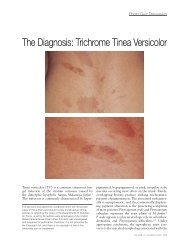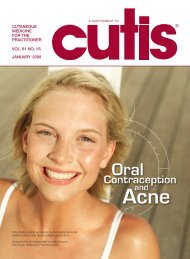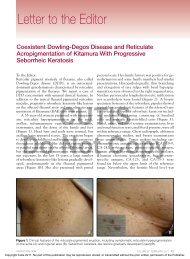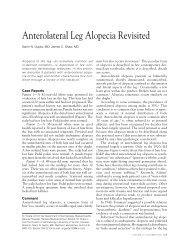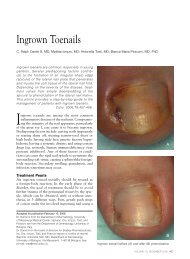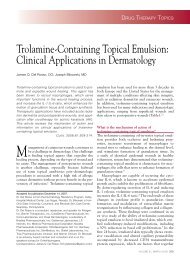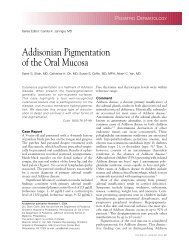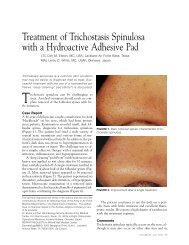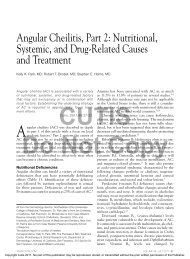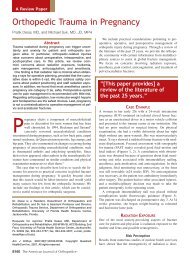The Role of Stimulatory Fillers in Aesthetic Facial Rejuvenation
The Role of Stimulatory Fillers in Aesthetic Facial Rejuvenation
The Role of Stimulatory Fillers in Aesthetic Facial Rejuvenation
Create successful ePaper yourself
Turn your PDF publications into a flip-book with our unique Google optimized e-Paper software.
<strong>Stimulatory</strong> <strong>Fillers</strong><br />
Figure not<br />
available onl<strong>in</strong>e<br />
Figure not<br />
available onl<strong>in</strong>e<br />
Figure not<br />
available onl<strong>in</strong>e<br />
A B C<br />
Figure 1. Pretreatment evidence <strong>of</strong> ag<strong>in</strong>g <strong>in</strong> a 63-year-old woman from 3 perspectives: right lateral (A), frontal (B), and left<br />
lateral (C) views.<br />
Photographs were taken before treatment at<br />
various angles aga<strong>in</strong>st a neutral background with<br />
consistent light<strong>in</strong>g to avoid shadows so that results<br />
can be reviewed and compared over time (Figure 1).<br />
Each series <strong>of</strong> photographs taken throughout the<br />
rejuvenation process should, ideally, have 5 views:<br />
frontal, left and right lateral, and left and right oblique.<br />
Photographs can also be useful when expla<strong>in</strong><strong>in</strong>g<br />
procedures to patients.<br />
Superficial Changes<br />
<strong>The</strong> panel agreed that the patient showed evidence <strong>of</strong><br />
photodamage, particularly on the neck, which required<br />
that she be exam<strong>in</strong>ed and treated for precancerous and<br />
cancerous lesions before undergo<strong>in</strong>g any aesthetic<br />
procedures. It was also recommended that she<br />
wear sunblock every day to protect aga<strong>in</strong>st further<br />
photodamage. <strong>The</strong> panel then weighed the specifics<br />
<strong>of</strong> how facial rejuvenation would be achieved. Each<br />
panelist was m<strong>in</strong>dful <strong>of</strong> the effect that a proposed<br />
correction would have on the patient’s appearance<br />
and took care to suggest compensatory corrections to<br />
ma<strong>in</strong>ta<strong>in</strong> the overall balance <strong>of</strong> her face.<br />
When queried by the moderator about the nature<br />
and extent <strong>of</strong> superficial changes and how best to<br />
address them, the panelists <strong>in</strong>itially focused their<br />
comments on the m<strong>in</strong>imization or eradication <strong>of</strong> signs<br />
<strong>of</strong> photodamage and rhytides.<br />
Photodamage<br />
Dr. Burgess: I would use a trichloroacetic acid<br />
peel or erbium laser to deeply exfoliate the sk<strong>in</strong> surface<br />
and address the discoloration and the precancerous<br />
lesions.<br />
Dr. Sherman: I agree; a chemical or laser peel would<br />
help m<strong>in</strong>imize the signs <strong>of</strong> photoag<strong>in</strong>g. However, if<br />
she does not want the downtime associated with a<br />
25% or 35% trichloroacetic acid or laser peel, a series<br />
<strong>of</strong> lighter peels us<strong>in</strong>g a-hydroxy acid, b-hydroxy<br />
acid, or both may provide an alternative for treat<strong>in</strong>g<br />
sun-damaged sk<strong>in</strong>. In addition to peel<strong>in</strong>g, I would<br />
supplement treatment <strong>of</strong> focal brown spots (lentig<strong>in</strong>es)<br />
and telangiectasias with a laser such as the Vari-Lite<br />
dual-wavelength (532 nm and 940 nm) laser system.<br />
COS DERM<br />
Dr. Buford: For a less <strong>in</strong>vasive option, <strong>in</strong>tense pulsed<br />
light therapy could be used to remove the brown spots<br />
and telangiectasias and rejuvenate the sk<strong>in</strong>.<br />
Do Not Copy<br />
Rhytides<br />
Dr. Burgess: She has a few rhytides <strong>in</strong> a horizontal<br />
plane on the forehead and vertical l<strong>in</strong>es <strong>in</strong> the glabellar<br />
area and across the nose bridge. Her hyperk<strong>in</strong>etic<br />
musculature def<strong>in</strong>itely could be relaxed with<br />
botul<strong>in</strong>um tox<strong>in</strong>. Because <strong>of</strong> the laxity <strong>of</strong> her upper<br />
eyelids, botul<strong>in</strong>um tox<strong>in</strong> <strong>in</strong>jections <strong>in</strong> the forehead<br />
l<strong>in</strong>es will probably cause brow ptosis, thereby<br />
<strong>in</strong>creas<strong>in</strong>g the hood<strong>in</strong>g <strong>of</strong> her upper eyelids. Outside<br />
<strong>of</strong> us<strong>in</strong>g botul<strong>in</strong>um tox<strong>in</strong> type A to produce a browlift,<br />
I would refer her to a plastic surgeon to consider<br />
blepharoplasty. <strong>The</strong>re are also rhytides around the<br />
mouth, which could be treated with botul<strong>in</strong>um tox<strong>in</strong><br />
and any temporary filler.<br />
Dr. Sherman: I am also concerned about the heavy<br />
appearance <strong>of</strong> the upper eyelids and would recommend<br />
consultation with a plastic surgeon for blepharoplasty.<br />
In the region <strong>of</strong> the superior temples, there is a crepelike<br />
appearance to the sk<strong>in</strong> and the superior-lateral brows<br />
seem to fall downward. PLLA may be used to volumize<br />
the temples and will create a vector to help lift the lateral<br />
brows. If she opted for a face-lift, I would recommend<br />
volumization with PLLA 4 to 6 months postsurgery.<br />
Tear troughs are another prom<strong>in</strong>ent feature and may<br />
be m<strong>in</strong>imized us<strong>in</strong>g small volumes (0.25–0.05 mL) <strong>of</strong><br />
Vol. 20 No. 11 s5 • november 2007 • Cosmetic Dermatology ® 7<br />
Copyright Cosmetic Dermatology 2007. No part <strong>of</strong> this publication may be reproduced, stored, or transmitted without the prior written permission <strong>of</strong> the Publisher.






